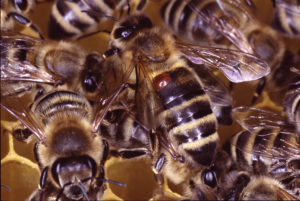DIY Varroa Mite Treatments
Varroa mites are a beekeeper’s worst nightmare. They can quickly travel from one hive to another, and ultimately decimate your colonies. Any infestation can be difficult to manage, but there are treatment options. However, you might not be comfortable using chemicals around your bees. Luckily you don’t need to, and you can make your own varroa mite treatments.
The Powdered Sugar Method
Powdered sugar is one way beekeepers can remove varroa mites from their hives. While powdered sugar is easy to find in any grocery store, that’s not the kind of powdered sugar you should use. You’ll start with regular sugar (confectioner’s sugar), and have to grind it into a powder.
Ultimately, you don’t need a lot of it- you don’t want to have too much extra stuck in your hive. Aim for about ½ cup for each box. Simply sprinkle it evenly throughout the box and clean up the extra as it drops to the bottom over time.
Why does it work?
As the sugar lightly coats the bees’ bodies, it encourages more intense grooming. Naturally, this also means that bees are more likely to remove the varroa mites themselves. Another reason the powdered sugar method works is that it makes it harder for varroa mites to attach to the bees. The powdery coating makes the bees feel more ‘slippery’ which allows more varroa mites to slip off bees and to the bottom of the hive.
The Essential Oils Method
Essential oils are touted for their many holistic uses, and it even extends to your bees. Of course, you can’t simply choose any essential oil- not all are as effective and safe to use around your beehive.
While there is a variety of safe and effective essential oils you can use, the best are thyme and mint. You don’t even need to apply the oils directly to your hive.
What you need:
- Thyme or mint essential oil
- Strips of clean fabric
- A bowl
The nice thing about using this method is that it works for a fair amount of time, and you need to do very little. Get your strips of fabric and put a small amount of essential oil in your bowl. Then, put the fabric in the bowl enough to absorb the essential oil.
After your fabric is soaked with the essential oil, remove it from the bowl and lightly squeeze any excess (dripping) oil out. Then, put the soaked fabric strips between each frame of your hive. It’s that simple.
It’s not important to make sure the fabric touches the bees. Bees will already lightly brush against it and spread the oils throughout the hive as they go about their daily activities. These fabric strips can stay between your frames for up to a week (no longer), although you should keep them in for at least three days.
Because the varroa mite life cycle will still continue with some mites that are still larvae waiting to emerge, it’s a good idea to repeat the treatment. Wait a few weeks and repeat your essential oil treatment to prevent the newly hatched mites from laying a new generation.
Why does it work?
Much like the powdered sugar method, the essential oil method gives bees a more slippery coating on their bodies. In turn, this makes it difficult for varroa mites to latch on to the bees, and it also successfully prevents the mites from being able to climb back onto the bees.
Benefits of the essential oil method:
- Natural and chemical free
- Won’t affect honey or hive activities
- Highly effective
- Evaporates quickly
- Can be repeated to eliminate newly hatched mites
